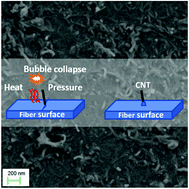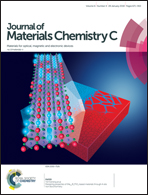Highly washable e-textile prepared by ultrasonic nanosoldering of carbon nanotubes onto polymer fibers†
Abstract
Electronic textiles (e-textile) have emerged as a new generation of wearable electronics. Although carbon nanotube (CNT) based e-textiles have drawn tremendous attention, a big concern is the washability of these e-textiles. Here, we describe a novel and facile method to fabricate e-textiles by ultrasonic soldering of CNTs on low cost and eco-friendly non-woven fabric (NWF). When a piece of NWF is subjected to ultrasonication in a CNT dispersion, the NWF can be locally softened so that CNTs can be soldered on the fiber surface and lead to conductive textiles. The ultrasonic nanosoldering of CNTs onto the polymer surface is attributed to the huge pressure and high temperature produced by the collapsing of bubbles during ultrasonication. The CNT e-textiles fabricated by this method have good washability. The CNTs remain on the fiber surface even after vigorous mechanical washing in water for 40 hours, and the conductance of the textile decreases slightly, and the change arises from the damage of NWF fibers rather than the rinsing away of the CNTs. The e-textiles can be used as wearable strain and pressure sensors. They can be used for healthcare applications such as monitoring the blood pulse and respiration rate of the human body.



 Please wait while we load your content...
Please wait while we load your content...